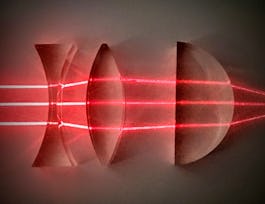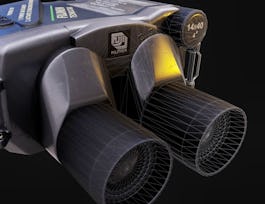This course will provide an in-depth exploration of desktop 3D printing hardware. It will examine the history of desktop 3D printing and demonstrate how 3D printers are made and how they work. This course will also provide step-by-step instructions for how to use and repair a 3D printer. It will also explore the different types of materials that can be 3D printed and will demonstrate how you can create various objects using these tools and materials. Learners who complete this course will be able to successfully operate, repair, and upgrade a 3D printer. In addition, learners who enroll in the course certificate will be able to purchase a desktop 3D printer at a discounted price (provided by Ultimaker).



3D Printing Hardware
This course is part of 3D Printing and Additive Manufacturing Specialization


Instructors: Matthew Griffin
Sponsored by PTT Global Chemical
15,344 already enrolled
(108 reviews)
What you'll learn
Understand the history and development of desktop 3D printers
Describe the different types of desktop 3D printers, how they work, what they are used for, and objects they can create
Set-up and prepare a 3D desktop printer for printing a test object
Identify 3D printable objects and prepare them for 3D desktop printing
Skills you'll gain
Details to know

Add to your LinkedIn profile
20 assignments
See how employees at top companies are mastering in-demand skills

Build your subject-matter expertise
- Learn new concepts from industry experts
- Gain a foundational understanding of a subject or tool
- Develop job-relevant skills with hands-on projects
- Earn a shareable career certificate


Earn a career certificate
Add this credential to your LinkedIn profile, resume, or CV
Share it on social media and in your performance review

There are 6 modules in this course
In this welcome module, you will become familiar with the course, your classmates, and our learning environment. In module 1, you will learn about “desktop” 3D printing as opposed to any other sort of 3D printing. You’ll learn this and more by exploring the history behind the creation of desktop 3D printers, overviews of the different types of desktop 3D printers, expose a few of the common misconceptions about them, and explore where you might gain access to them for yourself, including details to help you make an informed decision about the class of desktop 3D printer hardware that suits your specific needs and budget.
What's included
8 videos5 readings4 assignments1 peer review2 discussion prompts
From a distance, the process of 3D printing looks like magic. Step closer and see how all of the core systems and components work together to fabricate real physical objects from digital design files. We make our first of two excursions “under the hood“ to look at the core systems and components that together and in parallel bring function to 3D printers.
What's included
11 videos2 readings4 assignments1 peer review1 discussion prompt
Now that we have an understanding of the controls and motion system. Let’s take a closer look at the extrusion process and what makes 3D printer filament so special. Let’s learn about the materials and processing that they go through when being printed.
What's included
8 videos2 readings3 assignments1 peer review1 discussion prompt
Now that you have looked closely at the fundamental physical systems and components involved with how desktop 3D printers function, and how they can be operated in “normal” situations, it is time to explore the processes involved with preparing digital objects and creating the job files (G-Code, or variant) that will drive the fabrication process.
What's included
8 videos2 readings3 assignments1 peer review1 discussion prompt
Okay, you’ve taken a broad view of desktop machines in the context of the history of 3D printers, very close view of the specific components and systems underneath the hood, and have crossed back-and-forth across the virtual-physical divide -- now it is time to spend some time seeing what it is like to use them!
What's included
5 videos2 readings3 assignments1 peer review1 discussion prompt
In the final module we will then wrap up our exploration of operating desktop 3D printing hardware, covering the moment you hit print to fabricate a part, through to the stages that follow. We’ll wrap up the course with a section highlighting approaches to technical support, troubleshooting, and preventative maintenance, as long as some recommendations for common tools, mods, and add-ons we hope to help you on your own 3D printer experiences that will follow.
What's included
7 videos3 readings3 assignments1 peer review1 discussion prompt1 plugin
Instructors


Offered by
Why people choose Coursera for their career




Learner reviews
108 reviews
- 5 stars
57.40%
- 4 stars
19.44%
- 3 stars
10.18%
- 2 stars
6.48%
- 1 star
6.48%
Showing 3 of 108
Reviewed on Aug 7, 2020
A great course to start with 3D printing architecture and be familiar with different types of 3D printers and process parameter before, during and after printing.
Reviewed on Aug 21, 2020
Great. But It Was Only Verbally. It was Kind of Tough to Understand.
Reviewed on Jun 21, 2020
this is an excellent course. everything was perfectly scheduled and it is very useful.
Recommended if you're interested in Business

University of Illinois Urbana-Champaign

University of Colorado Boulder

Michigan State University

University of Illinois Urbana-Champaign

Open new doors with Coursera Plus
Unlimited access to 10,000+ world-class courses, hands-on projects, and job-ready certificate programs - all included in your subscription
Advance your career with an online degree
Earn a degree from world-class universities - 100% online
Join over 3,400 global companies that choose Coursera for Business
Upskill your employees to excel in the digital economy


